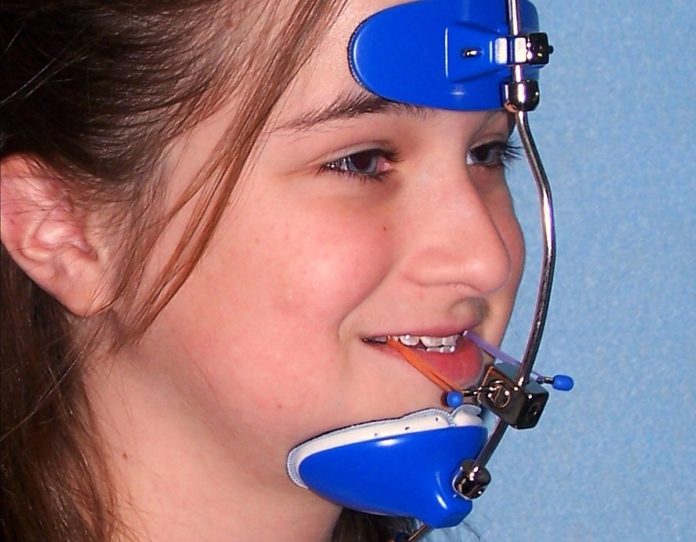Headgear braces are orthodontic appliances that are used to support jaw growth and alignment and also correct bite. There are many different types of headgear braces for kids for different concerns.
Orthodontic headgear is recommended for children who are still in the growing stage. Unlike normal braces, headgear braces work partially out of the mouth.
If your child bites severely out of alignment, then the orthodontist might recommend wearing dental headgear. An unaligned bite condition is known as malocclusion, where the upper and lower teeth do not fit together like they normally should.
In some cases, dental headgear is also used to correct tooth overcrowding.
Let’s learn everything about Orthodontic headgear braces. Keep scrolling down.
Basic parts of headgear:
Headgear comprises various parts, which vary depending on the type of headgear used and corrected condition.
PARTS OF HEADGEAR
- Head Cap- it sits on the head and provides support to the rest of the apparatus.
- Fitting Straps
- Facebook- a metal appliance in U shape is attached with tubes or bands to the head cap, molars, and straps.
- Elastic tubes, bands, and hooks to anchor different parts of headgear to other teeth.
- Mouth yoke, forehead pad, and chip cup.
- Braces- not every type of dental headgear needs to use braces. Some utilize the bands or hooks.
Read More- How To Get Rid Of White Spots On Teeth?
Different types of headgear
Below we have mentioned different types of Orthodontic headgear braces.
Cervical pull
A cervical pull headgear is used to correct the malocclusion known as overjet. This is a condition in which the front teeth and top jaw protrude. This is also known as buck teeth.
This type of dental headgear is also used to correct an overbite. Overbite is the misalignment of top and bottom teeth, causing upper teeth to jug out. Cervical headgear uses straps to wrap behind the neck and is attached to braces inside the mouth.
High pull
High-pull headgear is used to correct overbite or overjet. It uses straps attached to the upper jaw to the top and backside of the head. This type of headgear braces is often used in children with open bites, meaning no contact between front and bottom teeth. Also, the kids with excessive jaw growth at the backside have to wear high pull headgear.
Reverse pull
Reverse pull headgear is used for the correction of the underdeveloped upper jaw, also known as an underbite. An underbite also causes lower teeth jutting, which extends beyond the upper teeth.
How to use Orthodontic headgear braces?
When using dental headgear, it is important to follow all the instructions provided by your doctor.
One of the biggest elements that decide the success of headgear is wronging them around 12-14 hours every day. Children at times may resist wearing headgear outside or at school. Your orthodontist may recommend wearing the headgear as soon as the school is over and keep wearing it through the night.
The longer your child will wear headgear, the faster they will be able to get off it. Unfortunately, headgear’s little progress can be undone if you do not wear it even for a day.
Read More- What Can You Eat After Removing The Wisdom Tooth?
Benefits of wearing headgear:
Headgear is used for correcting jaw and tooth misalignment and Laos tooth overcrowding. It helps to enhance the facial aesthetics of a person and correct their overall profile. Headgear braces also help in improving the child’s smile.
Headgear works by creating space between teeth and exerting force on the upper and lower jaw to stop teeth overcrowding and overlapping.
These are effective only in the growing years of a child. Headgear is able to hold back the extra growth of the jawbone and force it into proper alignment by enforcing consistent pressure.
Risks & Concerns associated with wearing headgear
Headgear is considered safe to wear if worn correctly.
You should never force a headgear on or off as it can cut through your gums and face and even damage the device.
Make sure your child follows all the instructions given by the orthodontist about how to put it on and off. This will prevent any damage to the device and them by snapping wires or rubber bands.
If your child complains of severe pain which does not go away, visit your orthodontist asap. Also, if your child is facing fitting issues, take them to the orthodontist, do not try to fit it yourself.
Do’s and don’ts of wearing headgear braces.
- Always remove your headgear when eating food. It is permitted to drink using a straw when headgear is on.
- You can brush your teeth while wearing the headgear, although removing it is better.
- Avoid eating hard candies and chewing gums when the headgear is on.
- Keep the headgear protected from any potential damage.
- Do not play contact sports while wearing headgear.
- Also, avoid skateboarding, ball games while wearing headgear, any sport which can cause an impact on the face or make them fall should not be played.
- Find activities which your child will enjoy when wearing headgear. Plan some at-home activities which are energetic and fun like dancing, card games, board games, or family aerobics.
What to expect when wearing headgear?
Headgear needs to be worn for at least 1-2 years. Your child will face some discomfort when wearing the headgear for the first time. They will also feel pressure when the orthodontist will deepen or adjust the gear, although it is temporary.
Provide soft foods to your child to avoid any further discomfort. Cold foods like ice creams and pops will feel comforting on their gums.
As the headgear is supposed to be worn for 12 hours, some kids will have to wear it to school as well. However, this can be a little challenging for kids because they can get embarrassed by how they look.
Make sure your child does not sneak off headgear, as even a little lapse in time can inhibit the progress made.
Read More- How Much Does A Tooth Implant Cost?
Final Words:
Dental or Orthodontic headgear braces are designed to correct tooth and jaw misalignment. There are many different types of headgear. Headgear is used when children are in their growing stages to ensure that the jawbone is moved into proper alignment. It is important to wear headgear every day for almost 12 hours till 1-2 years.
We hope this article was informative enough. If you find this post helpful, make sure to leave a comment down below.




